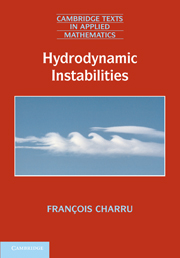Book contents
- Frontmatter
- Contents
- Foreword
- Preface
- Video resources
- 1 Introduction
- 2 Instabilities of fluids at rest
- 3 Stability of open flows: basic ideas
- 4 Inviscid instability of parallel flows
- 5 Viscous instability of parallel flows
- 6 Instabilities at low Reynolds number
- 7 Avalanches, ripples, and dunes
- 8 Nonlinear dynamics of systems with few degrees of freedom
- 9 Nonlinear dispersive waves
- 10 Nonlinear dynamics of dissipative systems
- 11 Dynamical systems and bifurcations
- Appendix A The Saint-Venant equations
- References
- Index
Preface
Published online by Cambridge University Press: 05 August 2011
- Frontmatter
- Contents
- Foreword
- Preface
- Video resources
- 1 Introduction
- 2 Instabilities of fluids at rest
- 3 Stability of open flows: basic ideas
- 4 Inviscid instability of parallel flows
- 5 Viscous instability of parallel flows
- 6 Instabilities at low Reynolds number
- 7 Avalanches, ripples, and dunes
- 8 Nonlinear dynamics of systems with few degrees of freedom
- 9 Nonlinear dispersive waves
- 10 Nonlinear dynamics of dissipative systems
- 11 Dynamical systems and bifurcations
- Appendix A The Saint-Venant equations
- References
- Index
Summary
La raison a tant de formes, que nous ne sçavons à laquelle nous prendre; l'experience n'en a pas moins.
Montaigne, Essais, Livre 3, 13.Reason has so many forms that we know not to which to take; experience has no fewer.
Montaigne, Essays, XXI. Of Experience, tr. Charles Cotton.For over a century now, the field of hydrodynamic instabilities has been constantly and abundantly renewed, and enriched by a fruitful dialogue with other fields of physics: phase transitions, nonlinear optics and chemistry, plasma physics, astrophysics and geophysics. Observation and analysis have been stimulated by new experimental techniques and numerical simulations, as well as by the development and adaptation of new concepts, in particular, those related to asymptotic analysis and the theory of nonlinear dynamical systems. Ever since the observations of Osborne Reynolds in 1883, there has been unflagging interest in the fundamental problem of the transition to turbulence. This topic has been given new life by concepts such as convective instabilities, transient growth, and by the recognized importance of unstable nonlinear solutions. New problems have emerged, such as flows involving fluid–structure interactions, granular flows, and flows of complex fluids – non-Newtonian and biological fluids, suspensions of particles, bubbly flows – where constitutive laws play an essential role.
This book has been written over the course of 10 years of teaching postgraduate students in fluid dynamics at the University of Toulouse. It is intended for any student, researcher, or engineer already conversant with basic hydrodynamics, and interested in the questions listed above.
- Type
- Chapter
- Information
- Hydrodynamic Instabilities , pp. xiii - xvPublisher: Cambridge University PressPrint publication year: 2011



